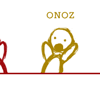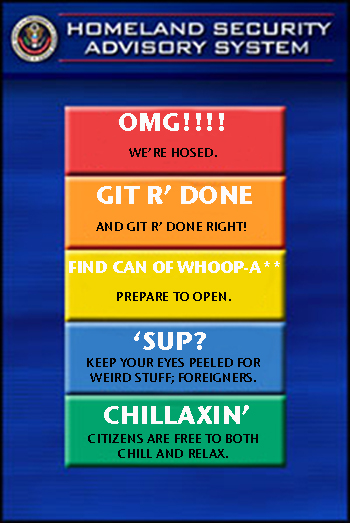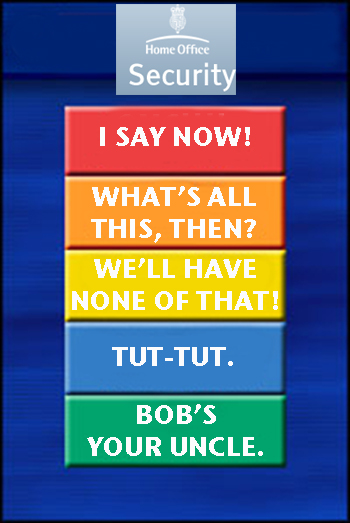Air travel, already a hellish and expensive ordeal, became even more ridiculous last week when the Transportation Security Administration (a division of the Department of Homeland Security) decided that the latest threat to airplane safety was: liquids. Not a specific liquid, mind you, but liquids in general. That’s right, an entire state of matter was banned. Next up: solids. Anything solid will have to be checked rather than carried on with you.
This wide, sweeping ban on non-solid and non-gaseous materials is in line with the Department of Homeland Security’s general policy on terrorist threats, which is that whenever the terrorists come up with a new strategy, Homeland Security will freak out and run around screaming like somebody tossed a snake into a slumber party. Remember when that lunatic tried to blow up a plane with his shoe? Immediately, it was assumed that everyone would be doing it, and so everyone had to take off their shoes at the checkpoint to make sure they were bomb-free. I have long held that if a terrorist ever succeeds in making a pants bomb, we’ll all be flying pants-less for several months thereafter.

And so the news was full all weekend of footage of travelers throwing away makeup, shampoo and bottled water at the airport checkpoints. (Why were they surprised to learn they couldn’t carry it onboard? Because they hadn’t seen a TV or newspaper or looked at the Internet or spoken to another human being in two days, apparently.) The travelers would say to the news people, “I don’t see how my foot-itch ointment is a threat, but I guess it’s better safe than sorry.” Everyone just kind of accepts that this kind of silliness is the way to protect ourselves against terrorism.
It isn’t, of course. The Department of Homeland Security, bless their hearts, has no idea how to make air travel safe. No one does. But they know that they need to LOOK like they know what they’re doing. Crazy bans on mouthwash and nail polish give the impression that Something Is Being Done, and that’s what helps us sleep at night. That, and liquor.
You notice, though, that they’re careful not to get TOO extreme with the restrictions, lest the people rise up and revolt. For example, liquids in the form of prescription medications are OK, provided the passenger’s name matches the name on the bottle. But couldn’t a terrorist fake a prescription bottle easily enough? Sure he could. But do YOU want to tell sick people they can’t bring their medications with them? Same with baby formula and baby food, both permissible if you’re traveling with an actual baby. Could a terrorist get a baby to use as a prop and put explosive liquids in the formula container? Absolutely. Most major cities have baby-rental services for people who need to use an infant for a few hours but don’t want the commitment of buying or making one themselves. And according to the TSA’s Web site, screeners in the U.S. aren’t making you drink the formula to prove it’s real, even though it would be really funny if they did.
Now, I’m not going to blow up a plane. I have no interest in doing so, though sometimes when I’m flying Southwest I can see why the thought appeals to some people. I’m just saying that no matter what precautions we take, if bad guys want to blow something up, they’ll find a way. That’s why we have the FBI and their cohorts working to discover these plots before they’re carried out. How they do it, I have no idea. It involves eyeing suspicious persons and eavesdropping on conversations, but I do that regularly when I’m out in public and I’ve never thwarted a terrorist plot. All I get are gems like the other day when two teenage girls were discussing supermarkets and one of them said, “Albertsons are expensive,” which is totally true, as you know if you have tried to purchase an Albertson lately.
So however the Feds are stopping these guys before they kill everyone, I’m glad they’re doing it, because goodness knows we’re not going to stop anyone at the airport security checkpoints. By Sunday night, while the liquid restrictions were still in place, things had calmed down enough for both the U.S. and England to lower their terror-alert levels from the highest to the second-highest positions. (See chart.)

The U.S. system.
|

The British system.
|
|---|
Source: Wikipedia
What does this mean to the average citizen? Nothing, of course. Telling us that a terrorist strike is imminent or expected doesn’t help us prepare for it. All we can do is the same thing we do every day, which is to be silently frightened any time we see a Muslim and to have dark fantasies about terrorist strikes in our city, wondering if we could heroically save anyone and whether we would get a medal for it. If that’s the same thing as being “vigilant” and “alert,” then I guess you can call me Vigilant McAlertness.
I was dismayed to discover that the British terror level system doesn't have a handy, familiar graphic to go with it the way America's does. So I had to use the U.S. version as the basis for the British version and alter them both with my mad Photoshop skillz.
The little graphic with the stick figures running around saying "OMG" and "ONOZ" (Internet slang for "Oh my gosh!" and [sarcastic] "Oh no!") came from parts unknown. I've seen it a few places recently and have no idea who created it. But it makes me giggle.




